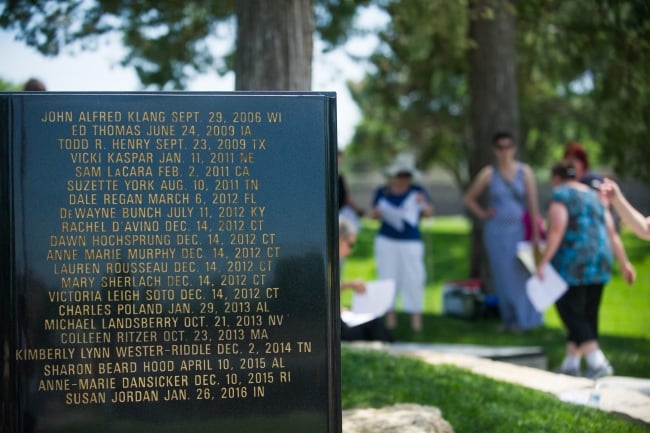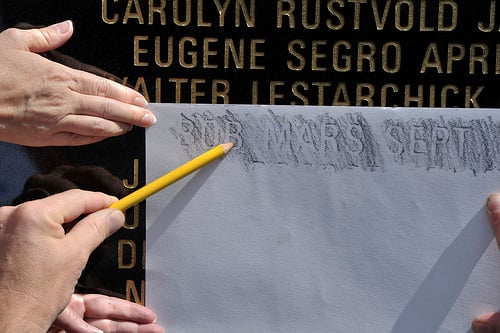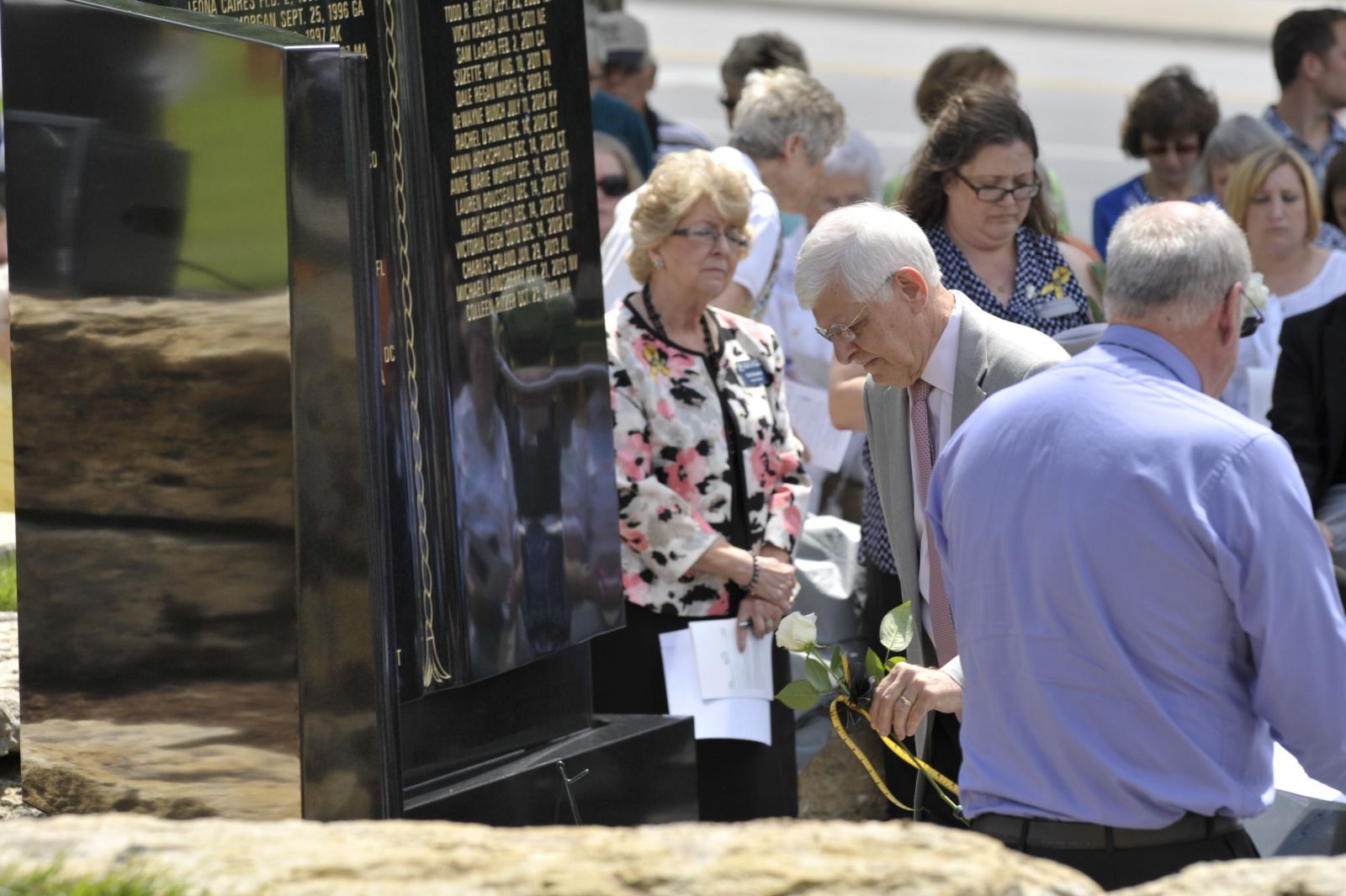You have /5 articles left.
Sign up for a free account or log in.

At the Memorial to Fallen Educators, names are engraved in the pages of two granite books.
The National Teachers Hall of Fame
Engraved in granite, there are 118 of them.
Sharon Beard Hood, 2015. Ollie Johnson, 2005. Hilda E. Taylor, 2001. The list goes back to Enoch Brown, killed in his schoolhouse in 1764.
The particulars of each tragedy aren’t written out. But visitors know what gets a name on the Memorial to Fallen Educators: school shootings, classroom fires, knife fights, car crashes, freak accidents. Any deaths -- any violent deaths -- that happened on the job.
Names are carved into the black granite pages of two six-by-six-foot books. The original plans called for only one book. But after they were compiled, the names spilled over onto both pages of a second.
The memorial, built by the National Teachers Hall of Fame, part of Emporia State University, only includes educators from prekindergarten through 12th grade. When it was designed -- just after the shooting at Sandy Hook Elementary in Newtown, Conn. -- the choice made sense to the organizers at the time.
But then Larry Levine and Ethan Schmidt died. Levine was the only professor killed at the Umpqua Community College shooting in October. Schmidt was a professor at Delta State University, shot by a colleague in his division in September.
Schmidt was also an Emporia State graduate. And so people started calling in: Will Ethan’s name be on the memorial?
Not yet, they were told. In mid-October, the National Teachers Hall of Fame voted to add victims from higher education. Soon friends and families of victims who died while serving colleges and universities will be able to locate their loved ones on the list of names.
But how long is that list? Nobody is sure. The National Teachers Hall of Fame will need to compile the names itself.
“That’s our first step,” director Carol Strickland said. “We don’t know whether we have to raise money for one book or two books or three books.”
Making the List
Just finding the names is daunting. In the best-case scenario, librarians, archivists and students will volunteer to comb through old newspapers and school records.
It’s not the kind of list that anyone has on file, though originally Strickland hoped it was.
“I was so naïve,” she said.
When planning the first two books, Strickland called the U.S. Department of Education and told Laurie Calvert, a teacher liaison there, that she needed a list of all teachers killed in the line of duty.
“There was just absolute silence,” Strickland said. “She said, ‘I don’t have anything like that.’”
Strickland worked through education groups, school boards and state affiliates, eventually coming up with the original 113 names. The memorial was unveiled in June 2014. In the two Junes that followed, a few more educators’ names were added.
 If all goes well, the updated engravings will likely be unveiled by 2018. Schmidt’s widow and children plan to attend.
If all goes well, the updated engravings will likely be unveiled by 2018. Schmidt’s widow and children plan to attend.
So does Roger Heineken, an administrator in Emporia State’s student union, who knew Schmidt when he was an undergraduate.
“It’s a place to remember,” he said. “It’s a place where Ethan’s children can bring their children to talk about their grandfather. It’s an indelible reminder that this person contributed to American society.”
Since Schmidt and Levine, the death toll has already grown. Just a few weeks ago, William S. Klug was killed at the University of California, Los Angeles. The memorial is a living document, and Klug’s name will be added to the list.
The memorial is located beside a one-room schoolhouse, a museum of sorts that has become a popular field trip destination for local school groups. When children migrate over to the memorial, they don’t necessarily understand the context, said Ken Weaver, dean of Emporia State’s Teachers College. But they know enough to recognize that there’s something more meditative, more meaningful, about their surroundings.
“Automatically, they turn quiet,” he said.
Defining ‘Educator’
On the memorial, educators’ names are listed next to the date and location of death. But on the memorial’s website, where space isn’t limited, each name comes with a story.
Sister Mary St. Canice, 1958: killed in a fire at Our Lady of the Angels, a Catholic school in Chicago, in the days before automatic fire alarms and sprinklers were commonplace.
Todd Henry, 2009: a music therapist, considered one of the best jazz guitarists in east Texas, stabbed during a classroom fight.
Sarah Clark, 2001: a teacher who was on the plane that hit the Pentagon, on her way to a field trip in California.
To be included on the list, the criteria is very specific: an educator must have been killed while on the job. Teachers who died at home from heart attacks are not included. Neither are those who died from domestic violence.
Clark, the teacher killed on 9/11, was accompanying students on a field trip, along with two fellow teachers. All three are on the wall. But a fourth teacher, heading home after a wedding on the same plane, is not. The higher education lists will use the same criteria.
At the same time, “educator” is defined broadly. Teachers, substitute teachers, principals, custodians, administrators and superintendents are all named on the memorial, and the higher education lists will be equally inclusive.
The memorial includes people like James McGee, a principal. He’s the only victim on the memorial from Kansas. When he was killed in a 1985 school shooting, his wife was pregnant with their fourth child. His son attended the 2014 ceremony and laid flowers by the memorial.
Then there’s Charles Poland, an Alabama school bus driver. When a gunman boarded his bus, Poland tried to block the aisle. It was seven weeks after Sandy Hook. All of the children survived, but Poland was killed.
Poland was a member of the National Education Association, Strickland said. He considered himself an educator. He died on the job, protecting a bus full of children.
So yes, Strickland said, he counts.




